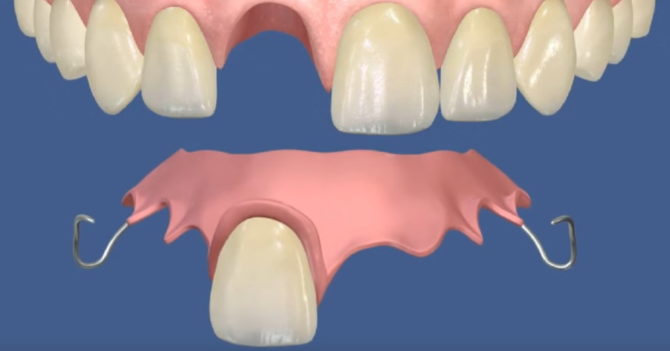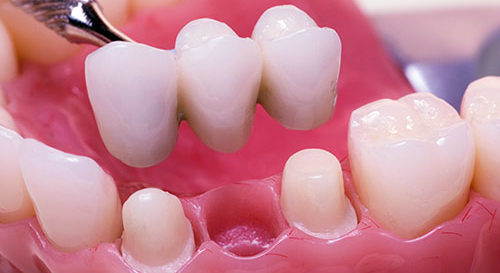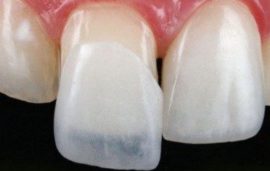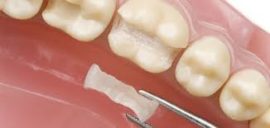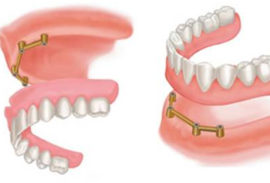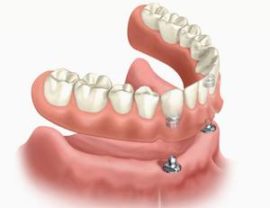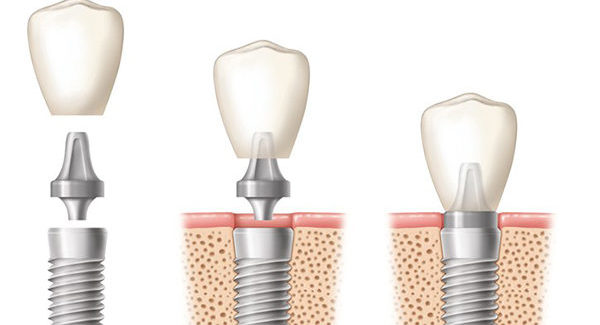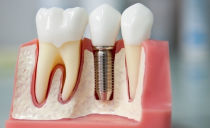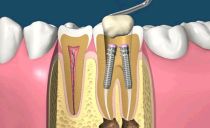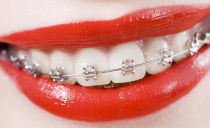Types of false teeth, which teeth are better to insert
Through prosthetics, the integrity of the dentition, as well as the appearance and shape of damaged teeth, can be restored. The choice of the type of false teeth depends on the condition of the oral cavity, the patient's health and financial aspect. The main task of the orthopedist is to restore the chewing function of the dentition. For the patient, aesthetics and the convenience of wearing the prosthesis are no less important.
Content
What teeth can be inserted
There are many options for prosthetics, but you can not always insert any design you like. For instance, when restoring chewing teeth, it is necessary to choose dentures from the most durable materials, and when replacing incisors and fangs located in the smile zone, the most aesthetic.
The design features of prostheses should also be considered. They are single, partial and complete. Single replace one tooth, partial several dental units in a row, and full entire dentition. In addition, dentures can be removable and non-removable.
Options for fixed teeth
Fixed prostheses are designed to be worn continuously for several years. Such structures may only be replaced or repaired if absolutely necessary. The supporting elements for their attachment are preserved teeth, dental roots or implants.
Fixed prostheses are fixed using cementing materials that connect them to the support. Such structures are best placed in the absence of several teeth in a row. But this does not mean that fixed prosthetics cannot be used for a single restoration.
Fixed prostheses come in several varieties:
- crowns;
- bridges;
- microprostheses.
About crowns
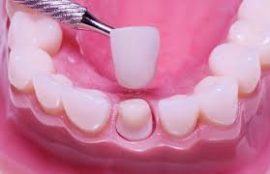 Dental crowns are made in the form of a tooth. They are a design that imitates a natural crown. There are ceramic, cermet, metal, plastic and zirconia. They are placed on top of a fully preserved dental root, stump insert, or implanted titanium implant.
Dental crowns are made in the form of a tooth. They are a design that imitates a natural crown. There are ceramic, cermet, metal, plastic and zirconia. They are placed on top of a fully preserved dental root, stump insert, or implanted titanium implant.
Bridge structures
Bridges are inserted into stump masonry or own teeth. In the absence of supporting teeth and roots, implants are implanted.
Bridge structures are used to restore several dental units located nearby.
Micro prosthetics in dentistry
By means of micro prosthetics they improve the appearance of the teeth and eliminate small and significant damage. Options for micro prostheses:
- veneers;
- lumineers;
- tabs.
Veneers are the thinnest overlays that hide external defects on the front surface of the teeth. They perform only an aesthetic function, therefore, their insertion is shown only when restoring units located in the smile area. After installing the veneers, the teeth look even and white.
Lumineers perform the same function as veneers, but differ in their smaller thickness and the fact that they can be placed without first turning the teeth. The cost of lumineers is several times higher than the price of veneers. This is the most expensive method of restoring the aesthetics of the dentition.
Tabs are structures used to restore damaged teeth. They allow you to eliminate chips and cracks on all sides of the dental unit, restore the natural shape and functionality of the tooth. Tabs are popular for their aesthetic appearance and ease of installation.
Microprostheses are made in the dental laboratory or directly in the patient’s mouth, in the first case, the restoration process can be delayed for a rather long time.
Types of removable false teeth
In the absence of many teeth, removable plug-in structures are most often installed. Often this type of prosthetics is chosen when it is not possible to install fixed prostheses. A contraindication to it is the acute stage of gum disease.
Removable jaws have several disadvantages. Over time, they contribute to atrophy of bone tissue, which becomes an obstacle to implantation. They also require regular adjustments due to changes in bone tissue.
The advantages of removable dentures are affordable, fast manufacturing, aesthetic appearance and easy care. They are suitable for long wear and are removed every day at night. Removable prosthetics can be used as a preparatory stage before installing fixed prostheses.
Removable constructions for prolonged wear are based on preserved teeth or implants implanted in the bone tissue of the jaw. They do not require regular removal, but if necessary, they can be removed from the oral cavity and put back in.
In the absence of all teeth, the structure is held by the principle of a suction cup. In addition, complete removable dentures are fixed in a beam or spherical manner. When a beam prosthesis is connected to the implant through a plate, which contributes to an even distribution of the load on the gums. This method of attachment can be used for prosthetics not only of the entire dentition, but also of extreme chewing units - when there is no support.
The spherical mount is in the form of a ball that attaches to the implant. It does not provide an even load distribution and is loosened with regular removal of the structure.
Implantation and placement of prostheses
Implantation is part of the prosthetics process and expands the possibilities in the field of orthopedics. Implantation of implants is required in the absence of their own dental roots, which could be used as a support for the prosthesis.
There are collapsible and non-collapsible implants. The collapsible structure consists of an artificial root and an abutment attached to it, to which a crown or prosthesis is attached. Non-separable implants are also equipped with an abutment, but have an integral structure.
Implants are strong and stable. With their help, you can restore single teeth without grinding the neighboring ones. For the manufacture of structures using high-quality and durable titanium.
Crowns from which materials it is better to insert instead of the front and chewing teeth
For the manufacture of prostheses, various materials can be used that have both advantages and disadvantages. The same prosthesis can have different properties, depending on what it is made of.
Instead of front teeth, which include central, lateral incisors and fangs, it is recommended to install structures made of the most aesthetic materials, as they are visible to others during a conversation and a smile. When restoring chewing teeth - following the fangs of premolars, first, second and third molars - the installation of crowns from the most durable materials is shown. They must withstand a large load, as they participate in chewing food.
The main materials used in orthopedics for the manufacture of false teeth:
- metal;
- metal composite;
- cermets;
- ceramics;
- plastic;
- zirconium dioxide.
Metal
Metal structures are characterized by high strength, so they are well suited for the restoration of chewing dental units. Due to their low aesthetics, they are not used for prosthetics of incisors and fangs.
The disadvantage of the material is that it is susceptible to corrosion, which spoils the appearance of the prosthesis and affects the well-being of the patient. Metal can cause allergic reactions. The main advantages of metal structures are strength and durability.
Metal composite
Metal composite materials are used to make crowns that can be placed on your own teeth, stump inlays, pins and implants. The basis of such designs is a metal frame, which is covered with several layers of plastic.
Plastic is weakly held on metal, as a result of which it easily flies off during heavy use. This type of artificial teeth is not recommended for constant wear, since their service life is short.
Metal composite prostheses can only be placed instead of chewing teeth, as they quickly darken and lose their aesthetics.
Cermets
Cermet teeth are best inserted during the restoration of chewing units. Such prostheses have an aesthetic appearance, are durable and durable, but are not suitable for prosthetics of incisors and fangs, since the metal base can protrude through the ceramic coating.
Ceramics
Ceramic prostheses are most often used to repair incisors and fangs. The shade of material is selected individually.
Ceramic teeth are expensive, but very durable. They can be put in the presence of an allergy to metal. The disadvantages of ceramic prostheses include the duration of manufacture and high cost.
Plastic
Despite many shortcomings, plastic prostheses are still widespread in orthopedics. Plastic products are used to temporarily restore the integrity of the dentition, since they are short-lived and are characterized by low strength.
Plastic has a porous structure, which is why it absorbs dyes from food and quickly loses its aesthetics. In addition, bacteria can accumulate in the pores of the material.
Removable plastic prostheses interfere with speech and taste. The period of getting used to the plastic jaws is long. Of the advantages of such products, only low cost, simplicity and speed of manufacture can be distinguished.
Zirconium dioxide
Zirconia prostheses are very expensive, but they have many advantages. Such material is biocompatible and most faithfully copies natural teeth. It is suitable for restoring the entire dental row.
Zirconia dentures are durable and hypoallergenic. Unlike cermets, metal composites and plastics, the material is resistant to hot and cold temperatures. Often it is used for the manufacture of fixed bridges. Teeth made of this material are among the most expensive and the best.
What to look for before prosthetics
To select the most suitable denture, the following parameters must be considered:
- The condition of the mucous membrane of the gums. Periodontitis is a contraindication to almost all types of prosthetics.
- Arrangement of crowns: a turn and crowding.
- The condition of the crowns. If the crown is destroyed and cannot be restored with composite materials, then it is reconstructed using the anatomical tab.
- Stability of the root system.
- The condition of the tissues in the cervical region and the root of the tooth.
- Defective area size.
- The location of the restored dental unit. This is a determining factor in the choice of material for the manufacture of crowns.
When choosing the type of prosthetics, it is necessary to evaluate not only the design features of the products and the financial component, but also the state of health. Fixed prostheses can not be inserted by everyone, a contraindication to their installation is a lot of diseases. It is important not to conceal them from the dentist. It is he who must determine which false teeth are better to insert in a particular case.

